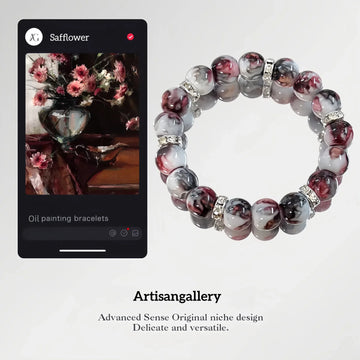Strengthening and Stabilizing Stone Bracelets for Long-Term Durability
Stone bracelets, whether crafted from delicate gemstones or robust minerals, require proactive measures to maintain their structural integrity and prevent damage. Over time, wear, environmental factors, or design flaws can compromise stability, leading to loose stones, frayed threads, or clasp failures. Below are practical methods to reinforce and stabilize your bracelets, ensuring they remain secure and beautiful for years to come.
Reinforcing Structural Components
Strengthening the foundational elements of a stone bracelet is critical to preventing breakage and stone loss. Focus on these areas to enhance durability:
- Clasp and Fastener Upgrades: Replace weak or worn clasps with sturdier alternatives designed to handle the bracelet’s weight. For example, toggle clasps can be swapped for magnetic or lobster-claw styles for added security. Ensure the new clasp matches the bracelet’s aesthetic and material.
- Prong and Bezel Adjustments: Loose stones are a common issue, often caused by worn prongs or bezels. Professionals can re-tip prongs, tighten bezels, or add protective settings to secure stones without altering their visibility. This is especially important for bracelets with cabochon or faceted stones prone to movement.
- Thread and Wire Reinforcement: For beaded bracelets, reinforce fraying or thinning threads with high-strength materials like nylon-coated wire or reinforced silk. Professionals may also knot beads more frequently to distribute tension evenly and prevent strand breakage.
Mitigating Environmental and Wear-Related Risks
External factors like humidity, sunlight, and physical stress can weaken a bracelet’s structure. Implement these strategies to minimize damage:
- Climate-Controlled Storage: Store bracelets in low-humidity environments to prevent metal tarnish, stone cracking, or adhesive degradation. Avoid exposing them to extreme temperatures or direct sunlight, which can cause fading or warping.
- Safe Wear Practices: Remove bracelets during activities that involve repetitive motion, heavy lifting, or exposure to chemicals (e.g., swimming, gardening, cleaning). This reduces the risk of snagging, stretching, or impact damage.
- Regular Inspections: Conduct monthly checks for loose stones, frayed threads, or stiff clasps. Early detection of issues allows for timely repairs, preventing minor problems from escalating into costly damage.
Adapting Design for Enhanced Stability
Sometimes, design modifications are necessary to improve a bracelet’s longevity. Consider these adjustments without compromising its original charm:
- Adding Supportive Elements: For bracelets with large or heavy stones, professionals may incorporate hidden supports, such as metal backing or additional prongs, to distribute weight evenly. This reduces strain on fragile settings.
- Resizing and Fit Adjustments: A bracelet that is too loose is more likely to snag or sustain damage. Resize it by adding or removing links, beads, or adjusting the clasp position to ensure a snug yet comfortable fit.
- Protective Coatings and Sealants: Apply temporary sealants to porous stones like turquoise or opal to prevent moisture absorption and cracking. For metal components, use clear protective coatings to resist tarnish and scratching without altering the finish.
Leveraging Professional Expertise for Complex Issues
While DIY methods help, some stability concerns require specialized skills. Seek professional assistance for:
- Structural Assessments: Jewelers can evaluate the bracelet’s overall integrity, identifying hidden weaknesses like thinning metal or compromised glue joints. Their expertise ensures repairs target root causes, not just symptoms.
- Advanced Repair Techniques: Professionals use tools like laser welders or precision adhesives to fix delicate components without visible marks. For example, they may reattach a fallen stone using invisible epoxy or realign a misshapen bezel with micro-pliers.
- Custom Stabilization Solutions: For heirloom or one-of-a-kind pieces, collaborate with a jeweler to design custom reinforcements, such as internal metal frames or adjustable tension systems. These solutions balance preservation with functionality.
By combining proactive maintenance, design adaptations, and professional care, you can significantly enhance the stability of your stone bracelets. Regular attention to structural components, environmental risks, and wear patterns ensures these pieces remain both secure and stunning, preserving their beauty for generations.







